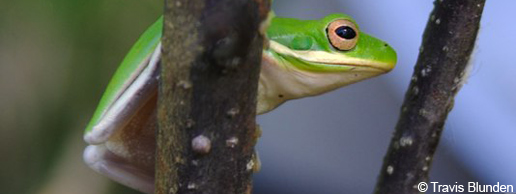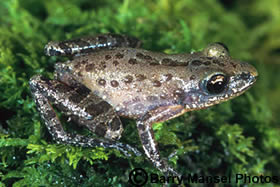
Florida Chorus Frog
Pseudacris nigrita verrucosa

Description: The Florida chorus frog was, and may still be, a common frog in Florida. Why don't we know for sure if it is still common? This frog's secretive nature makes it difficult to accurately measure its population numbers. In terms of range, this frog can be found in most of the peninsula, south of a line roughly from Cedar Key to Jacksonville.
Habitat: When calling, this tiny frog is usually hidden at the base of grass clumps at or near the edge of water -- with only its head above the water surface. These seldom-seen frogs inhabit flooded fields, wet marshes, drainage ditches, pine woodland ponds, and other similarly open habitats. They also inhabit ponds in woodlands that have dense understory vegetation.
Size: The Florida chorus frog reaches a maximum length of 1.25 inches and can vary greatly in color and intensity of pattern. If cold, they can be a dark charcoal color with the spots barely noticeable. When warm, the same frog can be light grey with bold charcoal-grey spots.
Reproduction: The breeding of Florida chorus frogs is determined by the occurance of rain. Winter rains in northern Florida allow for winter and early spring breeding, while the rainy season in southern Florida occurs from spring to autumn.
Call: The call of the Florida chorus frog is similar to the sound of a fingernail drawn over the teeth of a pocket comb. The speed of the call, or trill rate, varies with air temperature (faster when warm, slower when cold).
Development of these pages was a cooperative effort. Photos were supplied by Barry Mansell Photos and calls were provided by Paul Moler, state herpetologist for the Florida Fish and Wildlife Conservation Commission.


 Location: http://yourdomain.edu
Location: http://yourdomain.edu